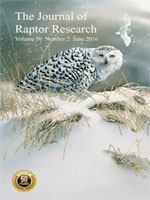Large numbers of Western Burrowing Owls (Athene cunicularia hypugaea) nest in black-tailed prairie dog (Cynomys ludovicianus) colonies in the southern high plains of Texas. Because the Western Burrowing Owl is a species of concern with an uncertain future due to widespread extirpation of prairie dogs, we examined the roles of prairie dog colony size, burrow density, proxies of prey availability, and vegetative composition and structure on owl abundance and reproductive rate. The number of nesting Burrowing Owl pairs was positively correlated to colony area (r2 = 0.550, P = 0.006) and to number of prairie dog burrows in a colony (r2 = 0.733, P = 0.0230). Burrowing Owl numbers and reproductive rate (maximum number of young seen per successful pair) were not related to our measures of vegetative composition and structure in prairie dog colonies, nor to indices of prey availability.
How to translate text using browser tools
1 June 2016
Factors Influencing Burrowing Owl Abundance in Prairie Dog Colonies on the Southern High Plains of Texas
James D. Ray

Journal of Raptor Research
Vol. 50 • No. 2
June 2016
Vol. 50 • No. 2
June 2016
Athene cunicularia hypugaea
Cynomys ludovicianus
population size
prairie dog
reproductive rate
Western Burrowing Owl




